The Portable Conventional Generator Market is estimated to be valued at USD 7.4 billion in 2025 and is projected to reach USD 10.8 billion by 2035, registering a compound annual growth rate (CAGR) of 3.8% over the forecast period. This steady but moderate growth highlights regional disparities in adoption, with Asia Pacific, Europe, and North America displaying distinct market imbalances driven by regulatory frameworks, energy security priorities, and usage preferences. In Asia Pacific, the market expansion is anticipated to outpace global averages, supported by rising power demand in residential, commercial, and construction sectors. Backup power generation is viewed as a necessity due to inconsistent grid reliability in certain economies, which sustains demand for conventional portable units despite global decarbonization trends.
North America, while technologically advanced, demonstrates moderate growth as regulatory restrictions on emissions restrain wider adoption. Consumers increasingly shift toward hybrid and cleaner alternatives, yet demand for portable conventional units remains resilient in disaster management and outdoor recreational segments. This region’s growth is steady but not aggressive due to stricter environmental policies. Europe represents the slowest growth trajectory, largely because emission-focused regulations and strong promotion of renewable-based portable systems suppress conventional generator deployment. Compliance costs, combined with policy-led disincentives, limit adoption to legacy applications. Asia Pacific drives forward growth, while Europe dampens momentum, and North America remains balanced between regulatory restraint and resilient use cases.

| Metric | Value |
|---|---|
| Portable Conventional Generator Market Estimated Value in (2025 E) | USD 7.4 billion |
| Portable Conventional Generator Market Forecast Value in (2035 F) | USD 10.8 billion |
| Forecast CAGR (2025 to 2035) | 3.8% |
The portable conventional generator market is experiencing consistent growth as consumers and industries seek reliable backup power solutions in the face of increasing grid instability and rising frequency of weather related outages. The demand is being further fueled by urbanization, growth in off grid construction activities, and the need for mobile energy sources in rural and remote areas.
Improvements in fuel efficiency, noise reduction, and compact design have strengthened adoption across both developed and developing regions. Government emphasis on emergency preparedness and the need for uninterrupted power during natural disasters have also encouraged widespread use.
With growing consumer awareness and technological upgrades improving product life and performance, the market outlook remains favorable for stakeholders focused on dependable and portable energy delivery.
The portable conventional generator market is segmented by fuel & power rating, end use, and geographic regions. By fuel & power rating, the portable conventional generator market is divided into Diesel, Gasoline, and Others. In terms of phase, the portable conventional generator market is classified into single-phase and three-phase. Based on end use, the portable conventional generator market is segmented into Residential, Commercial, and Construction. Regionally, the portable conventional generator industry is classified into North America, Latin America, Western Europe, Eastern Europe, Balkan & Baltic Countries, Russia & Belarus, Central Asia, East Asia, South Asia & Pacific, and the Middle East & Africa.
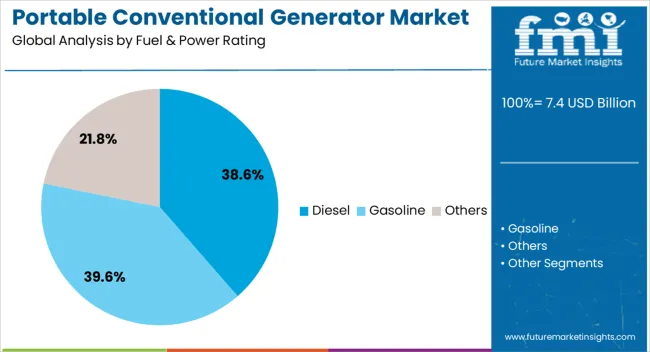
The diesel sub-segment under fuel and power rating is expected to account for 38.60% of total market revenue by 2025, marking it as the leading contributor within this category. This dominance is attributed to diesel’s superior fuel efficiency, longer operational lifespan, and suitability for high-power demand applications.
Diesel generators are particularly favored in areas with limited fuel accessibility and inconsistent power supply, due to their resilience and cost-effectiveness in long-duration use. Their ability to operate under heavy loads and in harsh conditions further strengthens their preference across construction sites and emergency scenarios.
As cost conscious consumers and businesses prioritize durability and low maintenance, diesel continues to maintain its position as the fuel of choice in this segment.
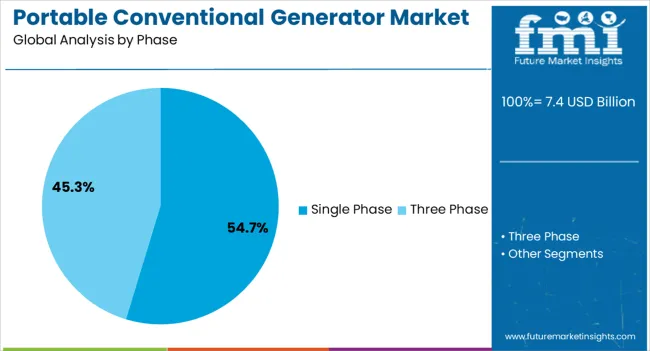
Within the phase segment, single phase generators are projected to capture 54.70% of the total market share by 2025, making it the dominant category. This leadership is driven by their affordability, ease of operation, and compatibility with residential and small scale commercial appliances.
Single-phase generators are well-suited for powering essential household devices and light-duty equipment, which aligns with their growing use in urban and semi-urban housing. Their lightweight and portable design makes them ideal for personal use, temporary setups, and mobile applications.
As consumers increasingly seek compact and reliable energy solutions for moderate power needs, the single-phase segment continues to expand its footprint.
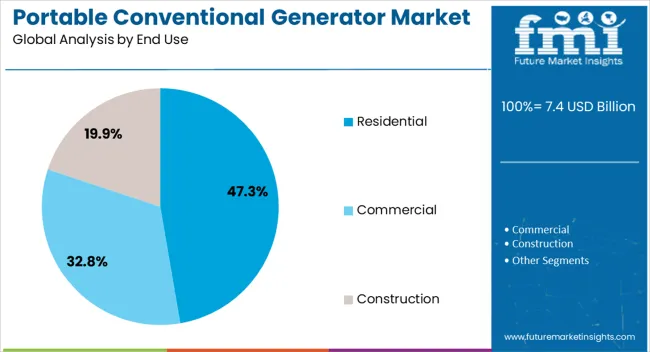
The residential end use segment is anticipated to contribute 47.30% of the total market revenue by 2025, positioning it as the leading application. This growth is supported by rising concerns over power outages, increased work from home trends, and the need for uninterrupted energy in domestic settings.
Portable conventional generators offer homeowners a dependable backup option during grid failures, especially in regions with aging infrastructure or severe weather patterns. In addition, consumer preference for home improvement and energy independence is influencing greater adoption of backup power equipment.
Ease of access, user friendly controls, and availability across retail channels have made residential users a significant growth driver in this market.
The market has been gaining attention due to the growing need for backup power across residential, commercial, and industrial sectors. These generators have been preferred for their cost-effectiveness, reliability, and ability to deliver steady power output. Unlike inverter models, conventional generators have been widely utilized in construction sites, outdoor events, and emergency backup situations where continuous power is required. Market expansion has been shaped by rising power outages, increased outdoor recreational activities, and demand for affordable alternatives to advanced generator systems.
The market has been influenced by rising concerns over electricity reliability and frequent outages. In many regions with unstable power infrastructure, portable generators have been used as dependable backup solutions. Their simple design and relatively lower acquisition cost have made them attractive for households, small businesses, and construction operations. These generators have been recognized for providing high power output over long durations, supporting critical equipment during outages. The widespread availability of fuel options such as gasoline and diesel has further increased adoption. With natural disasters and grid instability becoming more frequent, reliance on these units as backup power sources has been reinforced across different user segments.
Construction projects and outdoor activities have been strong contributors to the adoption of portable conventional generators. These units have been widely deployed at construction sites to operate tools, lighting systems, and machinery where grid connectivity is unavailable. Their robust design and high wattage capabilities have allowed sustained usage under demanding environments. Additionally, the popularity of camping, outdoor events, and recreational vehicle usage has supported generator sales for leisure applications. Portable models have been preferred over stationary systems for their mobility and ease of operation. The combination of affordability and reliable performance has made them a primary choice for temporary power solutions, thus sustaining market growth in both developed and developing regions.
The market has faced competition from inverter-based systems, which are lighter, quieter, and more fuel-efficient. However, conventional models have retained strong demand due to their higher power output capacity and lower purchase costs. While inverter generators have been marketed for sensitive electronic devices, conventional units have remained dominant in powering heavy-duty appliances, large tools, and prolonged operations. Consumers seeking cost efficiency and reliability have continued to prefer these systems despite advancements in inverter technology. Market growth has therefore been maintained by positioning conventional generators as high-output solutions for heavy loads where affordability and durability remain priority factors.
The growth of portable conventional generators has been restrained by environmental and regulatory pressures. Emissions from gasoline and diesel-powered models have raised concerns over air pollution and compliance with international efficiency standards. Noise pollution has also emerged as a limitation, especially in urban and residential zones. Regulatory bodies in North America and Europe have enforced stricter emission and noise control norms, leading to higher compliance costs for manufacturers. Despite these challenges, demand has been sustained in regions where affordability outweighs environmental considerations. However, continuous pressure from cleaner alternatives and renewable energy adoption has been expected to gradually impact long-term growth prospects of this market.
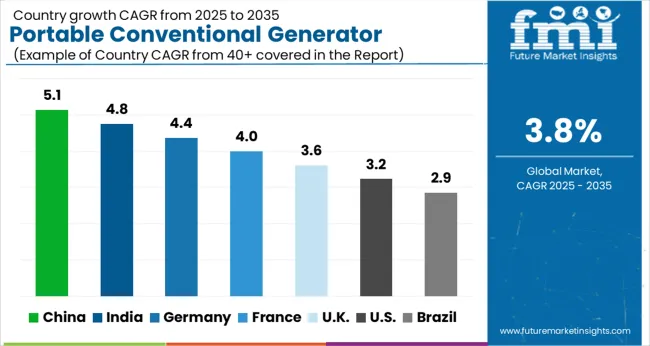
| Countries | CAGR |
|---|---|
| China | 5.1% |
| India | 4.8% |
| Germany | 4.4% |
| France | 4.0% |
| UK | 3.6% |
| USA | 3.2% |
| Brazil | 2.9% |
The market is anticipated to grow at a CAGR of 3.8% from 2025 to 2035, influenced by rising power backup needs across residential and commercial sectors. China leads with a projected growth rate of 5.1%, supported by large-scale manufacturing capacity and expanding rural electrification initiatives. India follows at 4.8%, where increasing infrastructure projects and frequent power fluctuations drive higher adoption. Germany records 4.4%, reflecting demand from construction sites and outdoor activities. The UK stands at 3.6%, with deployment concentrated in emergency backup and event applications. The USA shows 3.2%, supported by growing demand from small businesses and disaster recovery systems. This report includes insights on 40+ countries; the top markets are shown here for reference.
China is expected to lead the market with a CAGR of 5.1%. Demand is primarily supported by construction activities, residential backup power needs, and small-scale industrial usage. Frequent investments in infrastructure and manufacturing facilities are creating opportunities for generator suppliers. Growing requirements for uninterrupted power during outdoor activities and rural electrification projects are enhancing adoption. Manufacturers are focusing on compact designs, better fuel efficiency, and reduced noise levels to meet diverse consumer needs. Distribution networks are being expanded to cater to remote and semi-urban areas.
India is forecasted to witness a CAGR of 4.8%, supported by frequent power outages, rural electricity shortages, and growing construction projects. The hospitality sector, events industry, and small-scale businesses are adopting portable generators as reliable backup solutions. Demand is influenced by rising household usage in semi-urban and rural areas. Government initiatives for rural electrification are creating additional market opportunities. Manufacturers are focusing on cost-efficient models with improved runtime and fuel economy to cater to price-sensitive consumers.
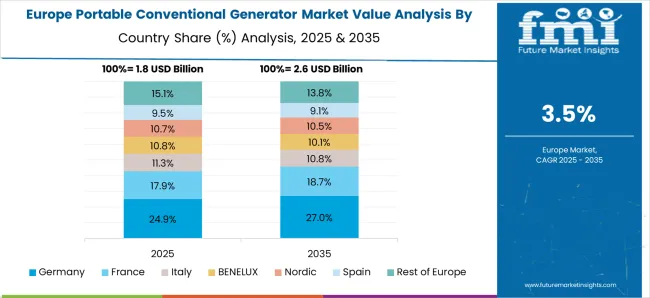
Germany’s market is projected to grow at a CAGR of 4.4%, driven by residential backup demand, construction activities, and recreational uses. The focus on energy reliability during emergencies is influencing adoption. Households are adopting portable generators for use during grid instability or outages. Construction sites are emerging as key buyers due to the need for mobile power. Manufacturers are improving fuel efficiency and portability features to match customer expectations. Partnerships with distributors are enhancing availability across retail and online channels.
The United Kingdom is estimated to grow at a CAGR of 3.6%, supported by demand from residential users, commercial facilities, and outdoor applications. Increasing reliance on mobile power solutions for events and outdoor activities is enhancing growth. The construction industry is also adopting portable generators for project sites lacking permanent power connections. Manufacturers are investing in compact models that comply with regulatory emission standards. Distribution through retail outlets and e-commerce platforms is expanding access to consumers.

The United States market is expected to expand at a CAGR of 3.2%, influenced by increasing demand for emergency backup during power outages and natural disasters. Residential usage remains a major growth driver, along with construction and outdoor applications. Events and camping activities are also contributing to rising adoption. Manufacturers are offering models with improved runtime, user-friendly controls, and lower emissions to comply with environmental standards. Distribution partnerships and aftermarket services are shaping competitive dynamics.

Allmand Bros. and Atlas Copco have built strong reputations with durable and efficient generator solutions suitable for challenging conditions. Briggs & Stratton and Champion Power Equipment are widely recognized for their extensive product portfolios tailored for residential and light commercial use. Caterpillar and Cummins remain dominant global players, offering high-performance systems that ensure power stability and efficiency.
Deere & Company, through its strong equipment portfolio, integrates reliable generator solutions to complement its agricultural and construction machinery. DuroMax Power Equipment, Firman Power Equipment, and Generac Power Systems play a vital role in serving the mid-range market, delivering portable options that are both affordable and reliable. HIMOINSA and Kirloskar strengthen the market with their specialized industrial-grade generators, while Honda India Power Products and Yamaha Motor contribute significantly with highly efficient, compact, and fuel-saving designs. Kohler and Mitsubishi Heavy Industries offer advanced generator models engineered for long operational life and high endurance. Westinghouse Electric Corporation maintains its presence through innovative portable power solutions, while YANMAR emphasizes robust and eco-friendly generators. Collectively, these companies drive innovation by enhancing portability, fuel efficiency, and operational reliability, which are essential in both developed and emerging markets.
| Item | Value |
|---|---|
| Quantitative Units | USD 7.4 Billion |
| Fuel & Power Rating | Diesel, Gasoline, and Others |
| Phase | Single Phase and Three Phase |
| End Use | Residential, Commercial, and Construction |
| Regions Covered | North America, Europe, Asia-Pacific, Latin America, Middle East & Africa |
| Country Covered | United States, Canada, Germany, France, United Kingdom, China, Japan, India, Brazil, South Africa |
| Key Companies Profiled | Allmand Bros., Atlas Copco, Briggs & Stratton, Caterpillar, Champion Power Equipment, Cummins, Deere & Company, DuroMax Power Equipment, Firman Power Equipment, Generac Power Systems, HIMOINSA, Honda India Power Products, Kirloskar, Kohler, Mitsubishi Heavy Industries, Snapper, Wacker Neuson, Westinghouse Electric Corporation, Yamaha Motor, and YANMAR |
| Additional Attributes | Dollar sales by generator type and power rating, demand dynamics across residential, commercial, and industrial sectors, regional trends in backup power adoption, innovation in fuel efficiency and noise reduction, environmental impact of emissions and fuel usage, and emerging use cases in outdoor activities and emergency response. |
The global portable conventional generator market is estimated to be valued at USD 7.4 billion in 2025.
The market size for the portable conventional generator market is projected to reach USD 10.8 billion by 2035.
The portable conventional generator market is expected to grow at a 3.8% CAGR between 2025 and 2035.
The key product types in portable conventional generator market are diesel, _20 kw, _20 - 50 kw, _> 50 - 100 kw, gasoline, _2 kw, _2 kw - 5 kw, _6 kw - 8 kw, _> 8 kw - 15 kw and others.
In terms of phase, single phase segment to command 54.7% share in the portable conventional generator market in 2025.






Our Research Products

The "Full Research Suite" delivers actionable market intel, deep dives on markets or technologies, so clients act faster, cut risk, and unlock growth.

The Leaderboard benchmarks and ranks top vendors, classifying them as Established Leaders, Leading Challengers, or Disruptors & Challengers.

Locates where complements amplify value and substitutes erode it, forecasting net impact by horizon

We deliver granular, decision-grade intel: market sizing, 5-year forecasts, pricing, adoption, usage, revenue, and operational KPIs—plus competitor tracking, regulation, and value chains—across 60 countries broadly.

Spot the shifts before they hit your P&L. We track inflection points, adoption curves, pricing moves, and ecosystem plays to show where demand is heading, why it is changing, and what to do next across high-growth markets and disruptive tech

Real-time reads of user behavior. We track shifting priorities, perceptions of today’s and next-gen services, and provider experience, then pace how fast tech moves from trial to adoption, blending buyer, consumer, and channel inputs with social signals (#WhySwitch, #UX).

Partner with our analyst team to build a custom report designed around your business priorities. From analysing market trends to assessing competitors or crafting bespoke datasets, we tailor insights to your needs.
Supplier Intelligence
Discovery & Profiling
Capacity & Footprint
Performance & Risk
Compliance & Governance
Commercial Readiness
Who Supplies Whom
Scorecards & Shortlists
Playbooks & Docs
Category Intelligence
Definition & Scope
Demand & Use Cases
Cost Drivers
Market Structure
Supply Chain Map
Trade & Policy
Operating Norms
Deliverables
Buyer Intelligence
Account Basics
Spend & Scope
Procurement Model
Vendor Requirements
Terms & Policies
Entry Strategy
Pain Points & Triggers
Outputs
Pricing Analysis
Benchmarks
Trends
Should-Cost
Indexation
Landed Cost
Commercial Terms
Deliverables
Brand Analysis
Positioning & Value Prop
Share & Presence
Customer Evidence
Go-to-Market
Digital & Reputation
Compliance & Trust
KPIs & Gaps
Outputs
Full Research Suite comprises of:
Market outlook & trends analysis
Interviews & case studies
Strategic recommendations
Vendor profiles & capabilities analysis
5-year forecasts
8 regions and 60+ country-level data splits
Market segment data splits
12 months of continuous data updates
DELIVERED AS:
PDF EXCEL ONLINE
Portable Hydrogen Generator Market Size and Share Forecast Outlook 2025 to 2035
Portable Inverter Generators Market Analysis by Power Rating, Power Source, Application, and Region through 2035
Portable Hydrogen Powered Generator Market Size and Share Forecast Outlook 2025 to 2035
Single Phase Portable Conventional Gensets Market Size and Share Forecast Outlook 2025 to 2035
Single Phase Portable Generators Market Size and Share Forecast Outlook 2025 to 2035
Construction Portable Generators Market Size and Share Forecast Outlook 2025 to 2035
Diesel Powered Portable Conventional Gensets Market Size and Share Forecast Outlook 2025 to 2035
Residential Portable Inverter Generator Market Size and Share Forecast Outlook 2025 to 2035
Diesel-Fired Portable Inverter Generator Market Size and Share Forecast Outlook 2025 to 2035
Construction Portable Inverter Generator Market Size and Share Forecast Outlook 2025 to 2035
Portable Audiometer Calibration System Market Size and Share Forecast Outlook 2025 to 2035
Generator Bushing Market Size and Share Forecast Outlook 2025 to 2035
Portable Crushers Market Size and Share Forecast Outlook 2025 to 2035
Portable Filtration System Market Size and Share Forecast Outlook 2025 to 2035
Portable Toilet Rental Market Size and Share Forecast Outlook 2025 to 2035
Portable NIR Moisture Meter Market Forecast and Outlook 2025 to 2035
Portable Appliance Tester (PAT) Market Size and Share Forecast Outlook 2025 to 2035
Conventional Palletizers Market Size and Share Forecast Outlook 2025 to 2035
Portable Boring Machines Market Size and Share Forecast Outlook 2025 to 2035
Portable Charging Units Market Size and Share Forecast Outlook 2025 to 2035

Thank you!
You will receive an email from our Business Development Manager. Please be sure to check your SPAM/JUNK folder too.
Chat With
MaRIA